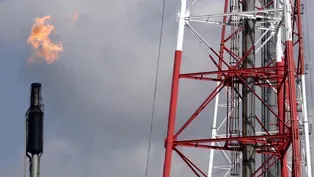
Gaia bids farewell after a decade of mapping the stars
Clip: 4/20/2025 | 4m 7sVideo has Closed Captions
Gaia space observatory bids farewell after a decade of mapping the stars
After more than a decade of mapping billions of stars across the Milky Way and beyond, a groundbreaking spacecraft is retiring. The European Space Agency’s space-based observatory known as Gaia is leaving behind a legacy of stunning discoveries that changed what we know about the universe. John Yang reports.
Problems with Closed Captions? Closed Captioning Feedback
Problems with Closed Captions? Closed Captioning Feedback
Major corporate funding for the PBS News Hour is provided by BDO, BNSF, Consumer Cellular, American Cruise Lines, and Raymond James. Funding for the PBS NewsHour Weekend is provided by...

Gaia bids farewell after a decade of mapping the stars
Clip: 4/20/2025 | 4m 7sVideo has Closed Captions
After more than a decade of mapping billions of stars across the Milky Way and beyond, a groundbreaking spacecraft is retiring. The European Space Agency’s space-based observatory known as Gaia is leaving behind a legacy of stunning discoveries that changed what we know about the universe. John Yang reports.
Problems with Closed Captions? Closed Captioning Feedback
How to Watch PBS News Hour
PBS News Hour is available to stream on pbs.org and the free PBS App, available on iPhone, Apple TV, Android TV, Android smartphones, Amazon Fire TV, Amazon Fire Tablet, Roku, Samsung Smart TV, and Vizio.
Providing Support for PBS.org
Learn Moreabout PBS online sponsorshipJOHN YANG: Finally this past week, astronomers at Cambridge University made headlines when they said they'd spotted indications of possible life on a distant planet using data from the James Webb Space Telescope.
Now, another space based observatory that's changed what we know about the universe is retiring.
The European Space Agency's craft, known as Gaia, is leaving behind a legacy of stunning discoveries.
JOHN YANG (voice-over): Gaia began its working life in 2013.
Launched with a clear mission.
Map our galaxy and tell its story.
The space observatory is equipped with an array of telescopes and instruments.
For more than a decade, it had slowly spun about a million miles from Earth, charting the precise locations of nearly 2 billion stars.
ANTHONY BROWN, Leiden University: I don't think anyone can imagine living without Gaia data anymore.
JOHN YANG (voice-over): Astronomer Anthony Brown of Leiden University in the Netherlands leads Gaia's data processing and analysis.
ANTHONY BROWN: Because we have the positions and brightness and colors of 2 billion stars in the sky, we can actually make a very beautiful all sky map of the Milky Way.
JOHN YANG (voice-over) But Gaia has helped create more than just beautiful maps.
Its data led to the revelation that 10 billion years ago, the young Milky Way collided and merged with a smaller galaxy.
Scientists are still exploring the cosmic fallout.
ANTHONY BROWN: A lot of the stars from that, let's say, intruder are still around, and we can identify them thanks to Gaia.
JOHN YANG (voice-over): Gaia completed one of the most comprehensive celestial catalogs in history, revealing more than half a million new stars within a cluster known as Omega Centauri.
Many of them zip through space at several hundred thousand miles an hour.
So far, Gaia's data has been used in more than 13,000 studies.
Brown used it to chart the path of stars in our night sky and predict their movements for the next 1.6 million years.
Its detection of a faint wobble in a star led to Princeton astrophysicist Joshua Winn's discovery of a massive planet many light years away.
JOSHUA WINN, Princeton University: Stars are very massive and they don't move very much in response to the gravity of a planet.
But the Gaia spacecraft is providing just the kind of data that we need.
JOHN YANG (voice-over): Cornell astronomer Lisa Kaltenegger used Gaia's findings to determine what planets outside our solar system would have a clear view of Earth, part of the search for life elsewhere.
LISA KALTENEGGER, Cornell University: More than a thousand stars could see us.
And we know which ones those are, because the Gaia mission gave us that information.
One out of five stars has a planet that's just at the right distance.
So not too hot, too close to the star, and not too cold, not too far away to potentially be like ours.
JOHN YANG (voice-over): A decade of hard work nearly exhausted Gaia's fuel.
It was time to say goodbye.
Its team on Earth sent the final commands to shut it down.
They also sent farewell messages, which will forever be stored in the spacecraft's onboard memory.
JOHANESS SAHLMANN, Mission Project Scientist: We are hundreds of people, more than a thousand, that work together.
JOHN YANG (voice-over): Physicist Johaness Sahlmann is mission project scientist.
JOHANESS SAHLMANN: We were witnessing something big that was ending.
And there was many emotions and there was tears in the room.
JOHN YANG (voiceover): Gaia's work may be done, but it left plenty to do on Earth.
Researchers have processed only about a third of the data it gathered.
JOHANESS SAHLMANN: At the end of next year, we will publish the next big data release.
Then this will open up again another treasure trove for all the scientists in the world to exploit.
JOHN YANG: Last month, Gaia's thrusters fired one last time to send it toward the galaxy's most familiar star.
The Milky Way's premier cartographer will spend the rest of its days orbiting the sun, taking a place of its own in our night sky.
How the closure of EPA offices puts poor communities at risk
Video has Closed Captions
How the closure of EPA offices puts poor and minority communities at risk (5m 19s)
News Wrap: Israel finds ‘failures’ in killing of Gaza medics
Video has Closed Captions
News Wrap: Israel finds ‘failures’ that led to killing of Palestinian medics in Gaza (3m 16s)
Ukraine, Russia trade blame for breaking Easter ceasefire
Video has Closed Captions
Ukraine and Russia trade blame for breaking Easter ceasefire as talks to end war drag on (5m 38s)
‘Utter desperation’ in Gaza amid Israel’s aid blockade
Video has Closed Captions
‘Utter desperation’ in Gaza after ceasefire collapse and Israel’s aid blockade (4m 58s)
Providing Support for PBS.org
Learn Moreabout PBS online sponsorshipSupport for PBS provided by:
Major corporate funding for the PBS News Hour is provided by BDO, BNSF, Consumer Cellular, American Cruise Lines, and Raymond James. Funding for the PBS NewsHour Weekend is provided by...















